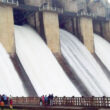Dr K Kasturirangan, Member, Planning Commission speaking at the event organized to mark World Environment Day. Image: UNDP
By: Thamoo Poovaiah & Thelapanda Pramod, Kodagu Ekikarna Ranga
The recent statements made by ‘responsible’ elected representatives on the implications of the Directions constituting Eco-Sensitive Areas based on the recommendations of the Kasturirangan Committee is highly misleading. Such statements and the ill-informed debate that is currently happening in Kodagu is extremely unfortunate.
Instead of explaining to the general public the real facts, the elected representatives either out of ignorance or under the influence of some vested interests are attempting to spread falsehoods which are generating fear in the minds of people. These unfortunate developments have now led to yet another review of the Directions issued by the MoEF on 13.11.2013.
Purely in public interest, we present below the Real Facts on the implications of the said Directions based on a very detailed analysis by legal experts.
1. What is in the Kasturirangan Report and in the Directions issued by the MoEF?
The High Level Working Group headed by Dr Kasturirangan(Member of Planning Commission, Former ISRO Chairman & Member of Parliament) – was constituted to review the recommendations made by the Committee headed by Prof Madhav Gadgil. The Kasturirangan Report’s most important recommendation is that only 37% of the Western Ghats are to be notified as Ecologically Sensitive Area (ESA). The rest of the 63% of the area has been designated as a ‘Cultural Landscape’ and excluded from the ESA to facilitate sustainable development. Accordingly, the MoEF accepted this recommendation and on 13.11.2013 issued directions under the Environment (Protection) Act, 1986 covering only 37% of natural landscape.
2. Where are those 37% area in Kodagu and how does it apply?
The ESA notification covers 37% natural forested areas having high biological richness, low population density and already existing Protected Areas (ie. National Parks & Sanctuaries), Tiger and Elephant corridors. The notification includes only 55 villages immediately adjacent to such Protected Areas/Forests. The entire district which has over three hundred towns and villages has not been notified as ESA. The list of villages as in the notification is at Annexure 01.
3. Will legally owned lands of farmers and planters be acquired?
As stated earlier, the Directions have been issued under Section 5 of the Environment (Protection) Act, 1986 and related Rules which does not empower the Government to acquire any land. It does not declare the intention to acquire any land even in respect of the 55 villages listed. Therefore the question of people losing their legally owned lands, located either in the identified villages or outside does not arise at all.
4. But will all bona fide activities of people including agriculture, coffee plantation, construction of houses, public utilities etc be prohibited?
Not at all. Growing of coffee, pepper, orange, paddy and such other agricultural and horticultural activities are fully permissible and there is no restriction anywhere including the 55 villages listed in the ESA notification. Most other business and commercial activities including home stays, tea/coffee processing, coffee curing roasting and grinding, commercial complex, manufacture of cement products like blocks, pipes etc, bricks and roofing tiles, wood furniture units etc are in the Green category and therefore permissible.
5. How are various activities classified?
The notification classifies all activities into three categories –
-
Green (which is fully permissible like agriculture, coffee, horticulture etc);
-
Orange (where some prior permissions are necessary) and
-
Red (which are prohibited) in the notified ESA comprising of Protected Areas, Forests and the 55 identified villages only.
6. But does the ESA extend to areas upto 10 km from the boundary of the identified villages?
The restrictions, if any, do not extend beyond the boundaries of the 55 identified villages upto 10 km. In other words, it applies only in the notified ESA which includes Protected Areas, Forests and the 55 identified villages. It is reiterated that restrictions do not apply outside the boundaries of the identified villages. Therefore the restrictions do not apply to entire hoblis and taluks in Kodagu district.
7. So what are the Prohibited Activities?
Only environmentally damaging activities are prohibited and that too within the notified ESA that includes Protected Areas, Forests and the 55 identified villages only. These are:
-
(a) Mining, quarrying and sand mining;
-
(b) Thermal Power Plants;
-
(c) Building and construction projects of 20,000 sq. m. area and above;
-
(d) Township and area development projects with an area of 50 ha and above and l or with built up area of 1,50,000 sq.m. and above
-
(e) Red category of industries (Annexure 02)
This makes it absolutely clear that the entire district of Kodagu will not suffer and all activities will not come to a standstill. Furthermore any activity that is now listed in the Red category but was legally permitted earlier will continue till the demise of the permission. In other words even mining activity which is on-going with all permissions will be phased out within five years or on expiry of the lease/permission whichever is earlier. We once again repeat that the ESA will cover already notified Protected Areas, Forests and only the 55 villages immediately adjacent to such areas – not the entire district.
[divider top=”no”]Courtesy: Coffeeland News






